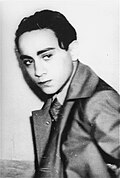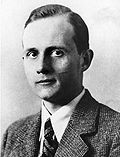Kristallnacht
pogrom against Jews throughout Nazi Germany on 9–10 November 1938 From Wikipedia, the free encyclopedia
Remove ads
Kristallnacht, also known as the Reichskristallnacht or Reichspogromnacht[1], was a two-day pogrom against Jews in Nazi Germany, Austria and the Sudetenland, parts of the then-Czechoslovakia. It occurred on November 9‒10, 1938. The name Kristallnacht means "Night of Broken Glass" in English. Kristallnacht was an important event leading up to the Holocaust. Various Nazi organizations participated, including the Schutzstaffel (SS), Sturmabteilung (SA), and Hitlerjugend (Hitler Youth). Many ordinary Germans joined in, motivated by antisemitism.[2][3]
This page or section needs to be cleaned up. (June 2025) |
The consequences to Jews were severe. At least a thousand were killed. Thousands more had their property looted or destroyed. Another 30,000 were deported to concentration camps after the pogrom. Fire departments and police stood by and watched.[4][5]
Remove ads
Name
The word "Kristallnacht" means "Night of Crystal" or "Night of Broken Glass" in English.[2][3] Not everybody agrees on this name. It has been called a euphemism because it does not mention violence, only property damage (particularly broken windows and crystal chandeliers). Additionally, -nacht ("night") suggests that the pogrom lasted just a single night, not two days.[4][6]
Assassination of Ernst vom Rath
On November 7, 1938, Ernst Eduard vom Rath, a diplomat at the German Embassy in Paris, was shot by a 17-year-old Polish Jew named Herschel Grynszpan.[7][8] Two days later, vom Rath died from his injuries, and Kristallnacht began.[2]
Motivations
On October 26, 1938, the Gestapo was ordered to arrest and deport all Polish Jews living in Germany.[9] This included Grynszpan's family, which had been living in Germany since the early 1920s.[8] With at least 12,000 others,[9] the family was deported to Poland after having all of their property seized.[8] From there, they sent a postcard to Herschel (who was living in Paris), explaining what had happened and asking for help.[2][3]
After shooting vom Rath, Herschel explained that he hoped to draw the world's attention to the persecution of Jews in Nazi Germany.[10] When French police arrested him after the shooting, he said:[10]
Being a Jew is not a crime. I am not a dog. I have a right to live and the Jewish people have a right to exist on earth. Wherever I have been I have been chased like an animal.
When he was arrested, Herschel was carrying a postcard he had written to his parents, further explaining his motivations:[8]
With God's help. My dear parents, I could not do otherwise, may God forgive me, the heart bleeds when I hear of your tragedy and that of the 12,000 Jews. I must protest so that the whole world hears my protest, and that I will do. Forgive me. Hermann [his German name].
Prior incident
There had been a similar event in February 1936, when a Jewish student named David Frankfurter assassinated NSDAP Secretary Wilhelm Gustloff.[11] Hitler was furious, but unlike on Kristallnacht, he did not allow the Nazis to take revenge against Jews.[12] He wanted the upcoming 1936 Summer Olympics in Berlin to be good propaganda for Nazi Germany. Scenes of violence, he worried, might cause other countries to boycott the Olympics.[12][2][3]
In 1938, Hitler no longer had these worries, and the Nazis punished tens of thousands of Jews after vom Rath's death.[2][3]
Remove ads
Pogrom
Looting
Kristallnacht began with massive property damage. Together the SA, the Hitler Youth, and German citizens targeted Jewish property all across Germany, Austria, and the Sudetenland. Specifically, they:[13][14][15][2]
- Destroyed and looted Jewish homes, hospitals, schools, and about 7500 businesses
- Destroyed Jewish cemeteries
- Damaged over 1400 synagogues and prayer rooms
- Destroyed 267 synagogues completely
Massacre
At least 1,000 Jews were killed during the night of Kristallnacht (though SS officers claimed that only 91 had died).[16] Many others were beaten or assaulted.[2]
Police reports of suicides and rapes increased after Kristallnacht.[13] A 2012 study reported that just in Austria, 680 Jews died by suicide on Kristallnacht.[17]
Arrests and deportations
More than 30,000 Jewish men were arrested during Kristallnacht and imprisoned in Nazi concentration camps (primarily Dachau, Buchenwald, and Sachsenhausen).[18][19] Many died there.[15][2][3]
Intensified persecution
The Nazi regime used Kristallnacht as an excuse to worsen their persecution of the Jews.[10] By the time World War II started months later, more than 200,000 had emigrated to escape this persecution.[2][3][4]
Financial punishments
The Nazis decided that the Jews should be liable for all of the property damage committed during Kristallnacht.[10] They punished Jews with a collective fine of 1 billion Reichsmarks (equal to about $400,000,000 in United States dollars at the time).[4][20]
When Jews who had lost property received insurance payments, the Nazis seized them.[18] If they had more than 5,000 Reichsmarks in assets, Jews were forced to give 20% of them to the state.[4]
Many Jews had their properties forcibly taken, or had to sell and abandon their homes, stores, and businesses.
New laws
The Nazi regime used the Kristallnacht as an excuse to completely remove Jews from German public life.[10][2][3]
After the pogrom, the Nazis made dozens of laws taking property and rights away from Jews. Under these laws:[13][2][3]
- "Aryan" people took over Jewish business and property, usually paying very little
- Jews were forbidden from practicing many professions, including teaching, medicine, and law (they were already ineligible for jobs in the public sector)
- Jewish children were expelled from German schools
- German Jews lost their right to have a driver's license or own an automobile
- Jews were restricted from using public transportation
- Jews could not enter “German” theaters, movie cinemas, or concert halls
Remove ads
Importance
Kristallnacht was an important event leading up to the Final Solution and the Holocaust.[21] It marked Nazi Germany's change from discriminating against Jews to systematically persecuting and deporting them.[2][3]
Gallery
- Kristallnacht started after Herschel Grynzpan (above) shot Ernst vom Rath
- Grynzpan was angry that Ernst vom Rath (above) had let his family be deported
- The Nazis destroyed many synagogues, like this one in Munich
- Home movie from Vienna showing how Jewish stores were destroyed
- A ruined synagogue in Germany
- Polish Jews being forced to leave their homes in Germany, 1938
Related pages
References
Wikiwand - on
Seamless Wikipedia browsing. On steroids.
Remove ads




